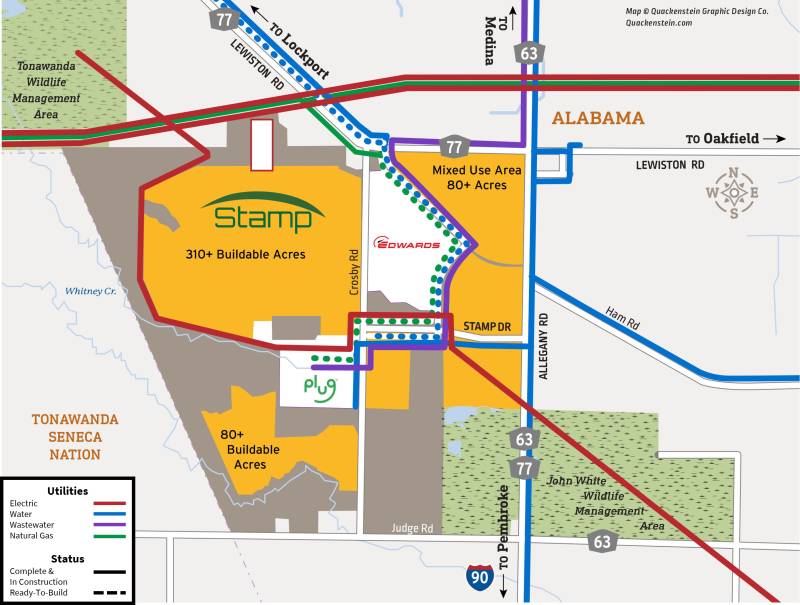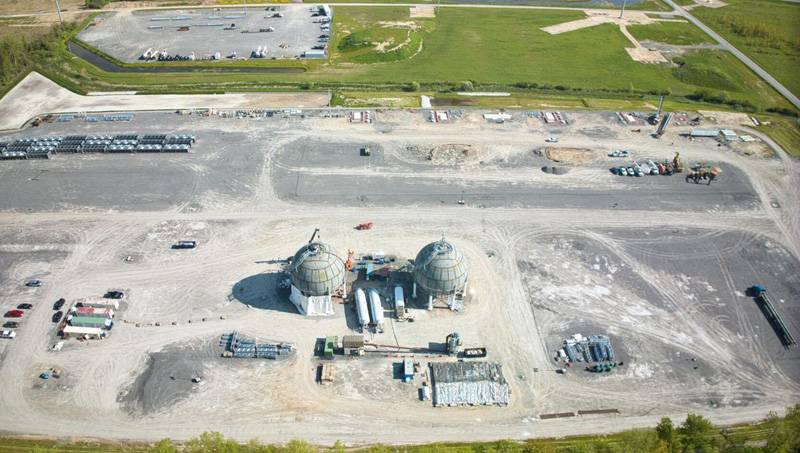
It's been 15 years since Steve Hyde first conceived of a massive, high-tech industrial park in Genesee County, and in 2023 Hyde is still focused on turning WNY STAMP into a fully realized mega site in the Town of Alabama even as the project faces its biggest legal challenges yet.
Hyde, the CEO of the Genesee County Economic Development Center, and Jim Krencik, the agency's marketing director, spoke with The Batavian on Friday primarily to discuss a new $56 million round of funding from New York State.
The infusion of cash, Hyde shared in his unbowed enthusiasm for all things STAMP, will help take STAMP -- with two projects already being developed -- to the next level, making it more attractive to a new wave of site selectors.
"It helps get Edwards what they need to get up and running and hiring their first 300 or so employees and building their first quarter million square foot factory," Hyde said. "The future is really that 310-acre campus (see map above) that's pretty much the largest available parcel in the state, and (the funding) fully makes it plug-and-play ready. That's really where I think the benefit is. That's where the interest is.
“You know, I couldn't have envisioned 15 years ago when this was a twinkle in my eye, and the board was helping me shape the thoughts and the strategy around it -- I just couldn't have imagined that 15 years later, we've got big sites like these out there. (We've got them) because of the chip sector, because of the Federal IRA (Inflation Reduction Act), because of the big focus right now -- all these big electric vehicle plants, battery plants, chip fabs, supply chain support for the chip fabs, solar projects,” he said. “There are less than two dozen mega sites at the same level of development as STAMP in the entire country. We're seeing deal flow right now like never before. And the more you can build the capacity, the infrastructure and really have it ready to support a company's timeline, it makes us far more competitive."
As part of STAMP's infrastructure, plans have been in place for years to build a sewer line that would run into Orleans County. After the sewer line was already approved and under construction, the Orleans County Legislature voted to file a lawsuit to halt the project, and an Orleans County judge issued a preliminary injunction to construction across the county line.
At the same time, GCEDC received notice from the U.S. Fish and Wildlife Service to temporarily halt the construction of a sewer line through the Iroquois Wildlife Preserve.
Hyde believes GCEDC will get past these challenges and be able to carry on with the agency's original plans, but if not, plans are being developed for alternative solutions, he said.
As for the lawsuit, Hyde said, "I'm really confident in the strength of our arguments."
The northern route for the sewer line, he said, is the most environmentally sound option, which is why the route was recommended by the Department of Environmental Conservation.
"If you look at the reality of what we're dealing with, in that case, that particular situation, it is DEC permitted," Hyde said. "They spent three years reviewing the plans. The DEC directed us to put the flow there because it was the best place for the care of that water body versus where we were looking as an option in Genesee County. It would have been more environmentally challenging than to do it in Genesee, and that was the reason they selected that area. There was careful study by the authority that has the responsibility for maintaining and protecting our environment. And they issued the permit. And that permit is far more stringent than what the Medina Wastewater Treatment Plant is currently operating under because they're grandfathered.
"So when I look at the challenges that are before us and presented, it's procedural things, and with procedural things, there are always ways to find solutions. So I am not at all concerned about proceeding, because it's a long pathway to do all this stuff anyway. And at the end of it, by proceeding, we're going to enjoy greater economic vibrancy here in this region."
Fish and Wildlife has not completely killed off the sewer line project with its stop-work order. GCEDC must come up with a plan to better contain and remediate potential environmental hazards during construction following two leaks in late summer and early fall of material used to help create boreholes for the pipeline.
In a previous interview with The Batavian, Mark Masse, VP of operations for GCECD, characterized the leak component as "mud."
He (Masse) said that during the construction of the wastewater pipeline, a channel is drilled through the subsurface and then filled with what is essentially mud to hold the line's shape while the pipe is slid into place.
"It's basically water and clay," Masse said. "The soil is so soft that it actually ended up going out through the soil. We've done the appropriate cleanups, we had an approved frac-out plan with the DEC ahead of time as part of our permitting. We are making improvements to it, and all of that cleanup and review is subject to the DEC review."
Asked to clarify what happened, Masse said, "In some cases in the refuge, the ground is so porous that when they put the mud in, it leaks out through the sides. It came up to the surface. And that's what they call a frac-out. But it is nothing more than mud. So we had vac trucks on site and cleaned it up. We have subject to DEC inspection on that and in accordance with our frac-out plan."
Calling the substance "mud" is technically accurate, but it is also an incomplete explanation.
There was a small spill in August, followed by a 100-gallon spill on Sept. 7.
Both spills contained "Wyoming sodium bentonite clay slurry," according to Fish and Wildlife.
Sodium bentonite is a naturally occurring substance, but it isn't naturally occurring in the water of a wetland.
It is a water-absorbent mineral clay. You might find it in your kitty's cat sand. It is also used as a cleansing agent in wastewater treatment, a clumping agent in metal casting, a sealant in water ponds, and, yes, as a mud additive (generally considered environmentally friendly in such uses) in drilling.
The biggest concern of Fish and Wildlife was apparently the lack of a swift response to contain and clean up the second spill and the lack of proper notification to regulators on the day of the spill.
Fish and Wildlife stated in its notice letter, "This discharge was not contained on the project site and ultimately spread over an area of approximately 200 feet by 120 feet."
It states that appropriate measures were not taken to implement, install and maintain measures necessary to prevent discharge of pollutants from the site.
"When department staff were at the site on Sept. 8, despite that the frac-out had occurred over 24 hours earlier, the fracking muds and fluids had not been removed from the impacted freshwater wetland and adjacent area, and no representatives of the permittee were present," states the notice.
Fish and Wildlife takes the spill and the response seriously enough that it notes GCEDC faces potential fines pending further investigation.
Before pipeline construction can resume, GCEDC must develop a plan to reduce the chances of future spills and for a better remediation effort if there is an accident.
About a week ago, in an email interview with Krencik, he stated:
Drilling for the force main installation has been halted for the construction season to avoid any conflict with snow removal services. In addition, at the request of regulatory agencies, additional geotechnical investigations have been performed to further define the soil conditions to assist our construction teams. GCEDC and the STAMP Sewer Works Corporation (SSWC) are working closely with NYSDEC and other regulatory authorities to resolve any concerns and ensure cleanup of the release of any drilling fluids from these two frac out events before resuming construction of the force main installation during permitted construction windows next season.
The $56 million awarded to STAMP by Gov. Kathy Hochul's office is the second considerable investment in STAMP by the state. In 2014, STAMP received $33 million for infrastructure and to jump-start project development.
"It's all about capacity," Hyde said. "That $33 million, especially in this era of inflation, got used for a lot of things. That money was used to build the initial infrastructure, but it was also invested in finishing up the design and permitting of the site, which of course, takes time and money. It built the baseline roadways, built some stormwater ponds, got us going on the force main ... it was really a lot of the engineering, design, the planning and permitting, baseline infrastructure. This (the new award) expands those capacities and adds some critical pieces."
Krencik added, "We've always been trying to stay ahead of where the market is. That (the $33 million) really got our foot in the door and enabled the first projects that you're looking at being implemented as phase one projects."
There is a 310-acre plot in STAMP that Hyde said is the largest such parcel available in the state, and the new round of funding will help make it more interesting to site selectors.
There is demand for the sites still available in STAMP, Krencik said.
"When you look across our sales funnel, that's what we're seeing," Krencik said. "The demand is roughly fitting in with us, and infrastructure, it takes time. That's why you do all the due diligence, all the permitting, getting all the permits for the DEC, the town of Shelby, all these pieces getting it done. It really gets ahead of these things. And with the substation being built, a lot of this stuff is being built. The state support is a pretty clear signal of what they're feeling."
The electrical substation, both Krencik and Hyde said, is a critical component of making STAMP more attractive to site selectors and more competitive with other industrial parks.
"Electrical infrastructure, that has been one of the longest lead time items we've faced, and it is coming in right now," Krencik said. "That's one of the biggest things giving companies confidence (in STAMP)."
Hyde said the substation will provide 600 megawatts of power, which is enough to power 600,000 homes and to energize high-tech companies at the scale they need.
And all of these numbers add up to more numbers, numbers in the form of good-paying jobs that won't require college degrees, Hyde noted.
"The beauty is, these jobs are kind of that next-level jobs for the community,' Hyde said. "I mean, our average income in our manufacturing jobs is in the low 60s right now, which is really good. It's good earnings for families, especially if you put a couple of those together, right? You have a good family-sustaining income. These jobs (at Plug Power and Edwards) are around 30 percent higher than that, so we're north of $80,000 on average between all the jobs being planned. That's kind of the goal, right? STAMP is about trying to elevate our economic vibrancy for our residents and our kids. The gratifying thing is that with the first two companies that have committed here, we're already seeing what the earnings and the wealth generation will be for our community."

Photo via Genesee County Economic Development Center.
